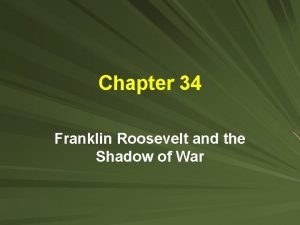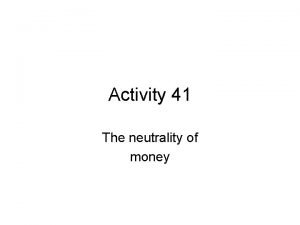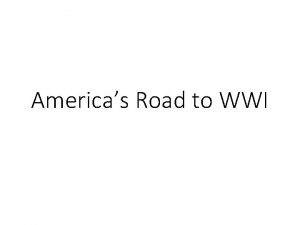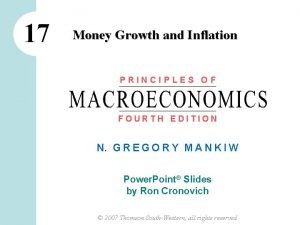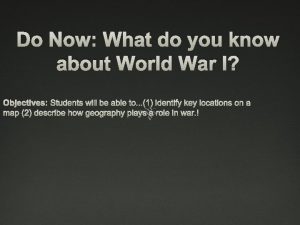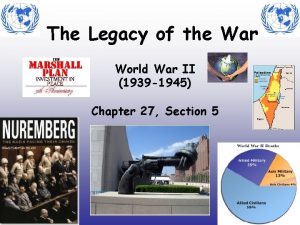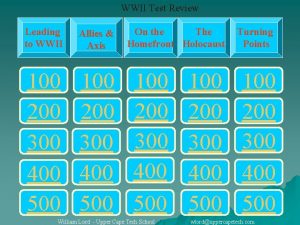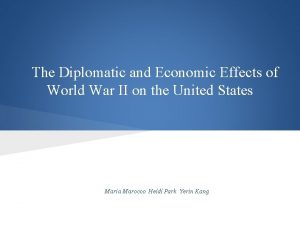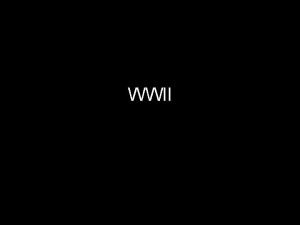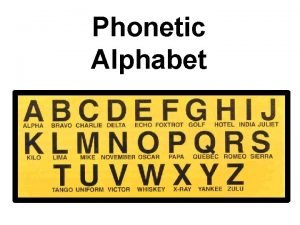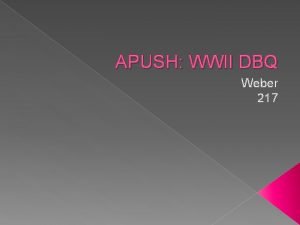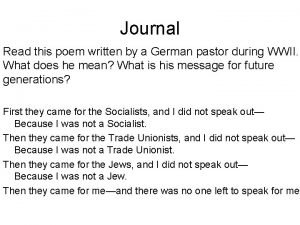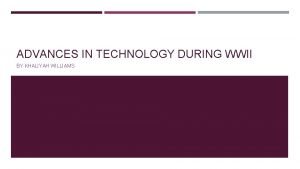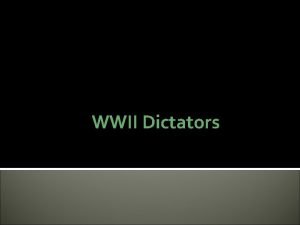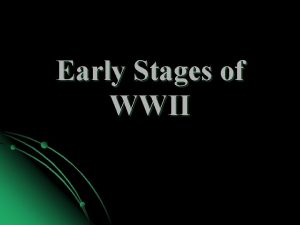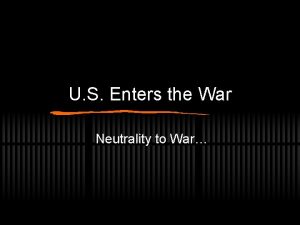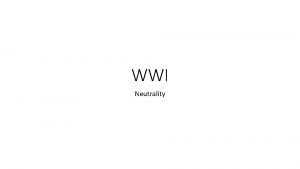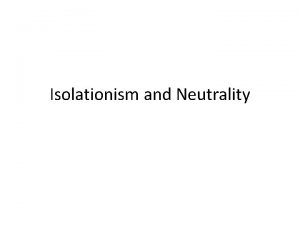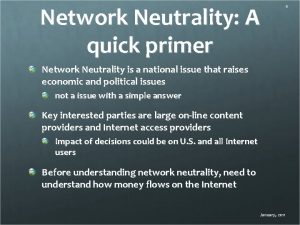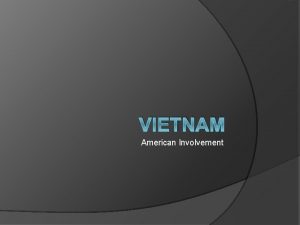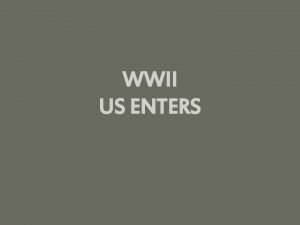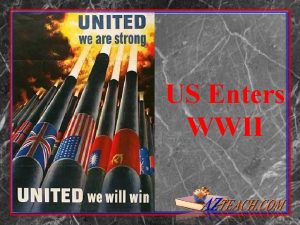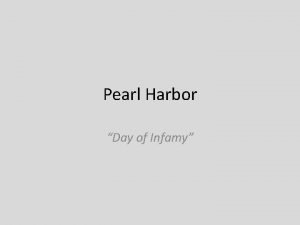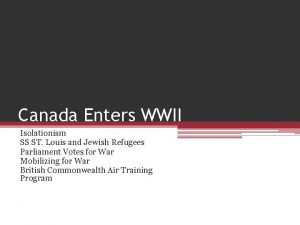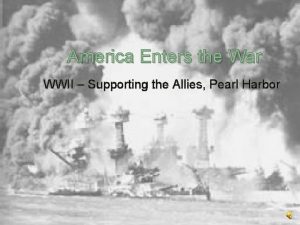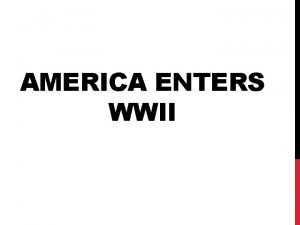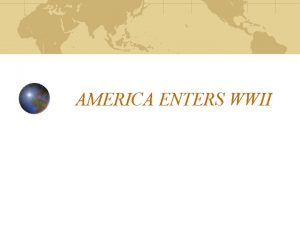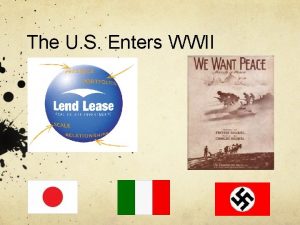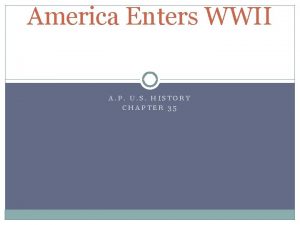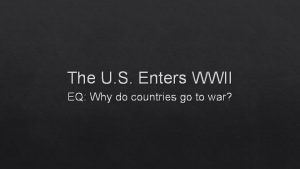US ENTERS WWII EARLY US INVOLVEMENT n Neutrality





















- Slides: 21

US ENTERS WWII

EARLY US INVOLVEMENT n Neutrality Act of 1939—FDR allowed British & French to buy US war supplies ¡ n Destroyers-for-Bases– trade US destroyers for naval bases in N & S America ¡ n Used cash & carry principle (pay cash for supplies, transport them yourself—US doesn’t get involved) US expands all over world Lend-Lease Act—Congress loaned Britain war supplies ¡ US tied to Britain by $

EARLY US INVOLVEMENT § Atlantic Charter—signed by FDR & Churchill in 1941 § Right of all nations to self-determination (deciding their future for themselves) § US & Britain wouldn’t try to gain territories from war § Disarmament—removal of weapons from aggressors (Italy, Germany) § “Permanent system of general security” in future § Beginnings of UN

ATTACK ON PEARL HARBOR • US opposed Japanese invasion of China (Manchuria) • Japanese believed that if US entered war, they would be against Japanese invasion of Indonesia • December 7, 1941—Japanese kamikaze pilots attacked Pearl Harbor, Hawaii • Sank 19 ships, destroyed 150 planes, killed 2335 soldiers & sailors • US declared war on Japan • Germany & Italy declared war on US

TAKING SIDES Allies Britain, France, US, Russia (eventually) n Axis Germany, Italy, Japan n

US MOBILIZATION n “Arsenal of Democracy”—US was only country that could produce goods for Allies n n Make war goods, not consumer goods Military enlistment men 21 -35 required to register for selective service in 1940 1945— 12. 5 million men & women serving in armed forces n African Americans placed in segregated units n

MOBILIZATION AT HOME n Women returned to workforce ¡ n Worked in support services in combat (not in active military) Gov’t financing US citizens bought war bonds to help pay for war ¡ Celebrities served in military or organized trips to entertain troops (USO)

MOBILIZATION AT HOME n Rationing factories changed production from consumer to military goods n Consumer goods limited (clothing, sugar, meat, rubber, gasoline) n Coupon book told people when they could buy certain things and what they could buy


WWII in North Africa • WHY? – Suez Canal – Shipping in Mediterranean Sea • Operation Torch – Nov. 1942 – Push Axis off N. Africa • Erwin Rommel

WWII in Italy n July 1943 n n n George Patton attacks Sicily Mussolini arrested No surrender from German troops n n Very bloody fighting 1945 Italy surrenders

The USSR Ø June 1941—Hitler broke Nazi-Soviet Non -Aggression Pact & invaded USSR l l Ø USSR entered war on side of Allies US provided support to USSR through Lend. Lease Battle of Stalingrad l Hitler defeated by Russian winter

EUROPEAN THEATER US helped Allies defeat Germany & Italy before going after Japan Ø Stalingrad—Germans defeated in S. Russia (August 1942 -January 1943) Ø l l Ø Russian winter caught Germans off guard Convinced Hitler that Germany could not advance East El Alamein—British defeated Germans in N. Africa (Oct. 1942) l l German general Erwin Rommel pushed out of Egypt into Tunisia Removed threat of German attack from South

D-Day Ø Tehran Conference—Dec. 1943 l l BIG THREE Attack on France • “Operation Overlord” • Dwight D. Eisenhower Ø D-Day June 6, 1944 l l Normandy Paris freed August 25, 1944

Battle of the Bulge Ø German attempt to divide Allies

Victory in Europe Ø Yalta Conference—Feb. 1945 l l BIG THREE What happens after the war? • Soviet Union: l l Declare war on Japan Free elections in E. Europe Keeps Poland temporarily ½ of all war reparations from Germany • Germany l l Divided into 4 pieces (US, France, GB, USSR) Establish UN

V-E Day Ø FDR dies—Apr. 12, 1945 Ø Hitler’s suicide—Apr. 30, 1945 l Unconditional surrender of Germany Ø V-E DAY—May 8, 1945 l Victory in Europe

PACIFIC THEATER • US forced to fight on 2 fronts – Free Europe – Keep Japanese from expanding • Japan controlled most of Asia & S. Pacific islands

MAJOR TURNING POINTS ¢ ¢ ¢ Battle of Coral Sea—first defeat of Japanese navy (May 1942) Battle of Midway—US defeated Japan & kept them from moving East (June 1942) Guadalcanal—first US offensive in Pacific (Aug. 1942 -Feb. 1943) Iwo Jima—used as stopping point for raids on Japan (Feb. -Mar. 1945) Okinawa—one of worst battles in Pacific (June-July 1945) l Used as base for planned invasion of Japan

ATOMIC BOMB n Albert Einstein (German Jew) fled Holocaust to work for US ¨ Manhattan Project—code name for project that created atomic bomb before Germany n Truman used bomb to achieve final, quick victory over Japan ¨ Dropped on Hiroshima & Nagasaki n Led to surrender of Japan

 Father involvement activities
Father involvement activities Neutrality acts 1935-37
Neutrality acts 1935-37 Net neutrality
Net neutrality Money neutrality
Money neutrality Wilson neutrality
Wilson neutrality Money supply growth rate formula
Money supply growth rate formula Fasb conceptual framework diagram
Fasb conceptual framework diagram Empathic neutrality
Empathic neutrality Balkan nationalism
Balkan nationalism Net neutrality
Net neutrality Monetary intertemporal model
Monetary intertemporal model Causes of ww2
Causes of ww2 Wwii test review
Wwii test review Wwii effects
Wwii effects Wwii picture
Wwii picture Map of german aggression wwii
Map of german aggression wwii Military words for letters of the alphabet
Military words for letters of the alphabet Zoot suit riots apush
Zoot suit riots apush Color tv started
Color tv started Wwii
Wwii Advances in technology during wwii
Advances in technology during wwii Wwii picture
Wwii picture

